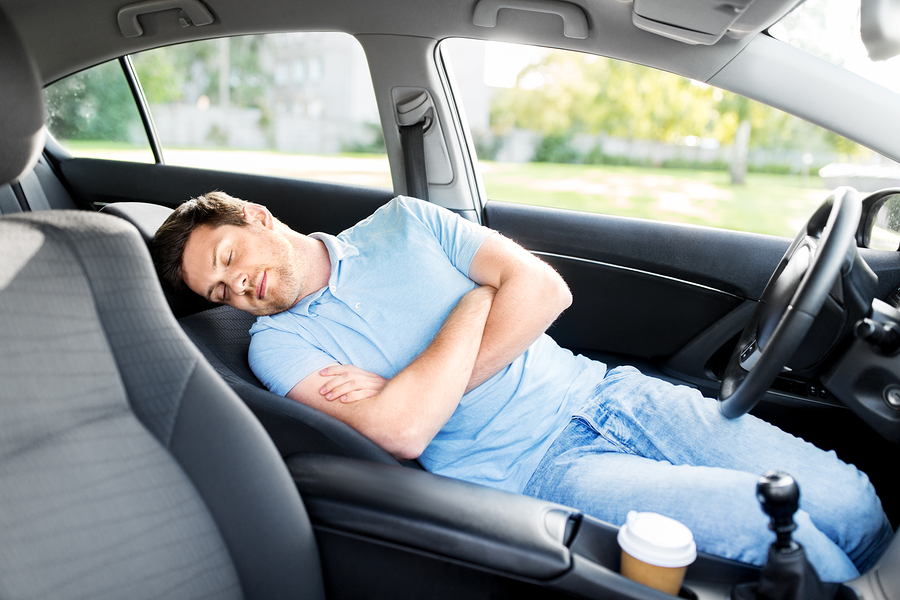Maybe you had a long shift at work, were hanging out late watching movies with friends, kept waking up every few hours with a crying baby, or maybe you’re just on a very long and boring drive.
Whatever the cause, driving while fatigued is dangerous, yet people do it all the time. According to a National Highway Traffic Safety Administration (NHTSA) survey, 37 percent of drivers report that they had nodded off for a moment or two, or have actually fallen asleep at some point, while driving. A staggering 7.5 million drivers in the United States admit to having fallen asleep at the wheel within the past month. Driver fatigue claimed 795 lives in 2017.
What Causes Driver Fatigue?
Multiple factors can contribute to driver fatigue. It usually happens when a driver has not gotten enough sleep, but other factors, such as alcohol, medications, or untreated sleep disorders, can also play a part.
According to the U.S. Centers for Disease Control and Prevention (CDC), the average adult should sleep seven or more hours each night, but more than a third of adults do not get the amount of sleep that they need. As of 2018, 38.7 Louisiana adults reported sleeping less than 7 hours in a 24-hour period. People often do not take sleep loss seriously. However, according to a study conducted by the AAA Foundation for Traffic Safety, drivers who got only five or six hours of sleep in the prior 24 hours were almost twice as likely to be involved in a car accident. Also, a sleep-deprived driver is just as dangerous as a driver with a blood-alcohol level of .08 percent, which is the legal threshold for intoxication.
Driver fatigue is a reflection of the world we live in. Many people are trying to balance the demands of work, family, and many other responsibilities. Workers are under pressure to work extended shifts, longer hours, or more than one job, so they are chronically tired.
Our bodies operate on a sleep/wake cycle, known as the circadian rhythm. Usually, the body’s sleep drive increases during the mid-afternoon and at night, so employees working long hours or night shift workers are especially vulnerable to fatigue.
Untreated sleep disorders also cause sleep deprivation. Many disorders, such as restless legs syndrome, sleep apnea, or narcolepsy, go undiagnosed, but they can cause extreme daytime sleepiness. Those with a sleep problem are more at risk for fatigue-related accidents.
Drinking alcohol consumption or consuming any medications, whether prescription or non-prescription, can cause driver fatigue. These substances may also intensify sleepiness stemming from any other cause.
A driver may not even be aware that he or she is tired. People sometimes experience microsleep, which lasts only a few seconds. However, it only takes a brief moment of sleep to cause an accident.
Contributing Factors to Driver Fatigue
Sleepiness can result in crashes any time of the day or night, but factors commonly associated with drowsy-driving crashes include:
- Sleeping less than four of the previous 24 hours means that a driver is more than eight times as likely to contribute to an accident
- Changing sleep schedules
- Fatigue-related accidents occur most frequently between midnight and 6 a.m., or in the late afternoon. During these times, people often experience dips in their circadian rhythm.
- Sundays and Mondays are the most common days for sleep-related accidents, possibly due to exhaustion from the weekend activities.
- Fatigue-related accidents frequently involve only a driver with no passengers, running off the road at a high rate of speed with no evidence of braking.
- These types of accidents often happen on rural roads and highways.
Effects of Fatigue on Driving
How much sleep do you need? This requirement varies from person to person and changes somewhat as we grow older, but in general, the amount of sleep we require remains consistent throughout our adult lives. Fatigue affects our cognitive abilities, including those needed to drive safely. Fatigue may lead to the following:
- Delayed reaction times
- Poor attention and concentration
- Bad judgment when reacting to road or traffic conditions
- Slowed or decreased motor skills
- Blurry vision
- Agitation or impatience with other drivers
- Driving too slowly or too fast
- Intensify impairment caused by medication
- Drifting across lanes
- Rolling stops
Who Is Most Likely To Drive Drowsy?
According to the National Highway Traffic Safety Administration (NHTSA), the drivers most at risk for drowsy driving are adults between 18 and 29 years of age. Experts estimate that younger drivers account for nearly two-thirds of fatigue-related crashes, though they account for only one-fourth of all licensed drivers. Men are almost twice as likely as women to fall asleep at the wheel. Adults with children living in the household are more likely to drive drowsy than those without children. Shift workers, medical staff, emergency providers, and law enforcement officers are also likely to suffer from fatigue, particularly when they drive home after work. Long-haul truck drivers are at risk. Approximately 15 percent of all large truck crashes involve fatigue. There are strict regulations requiring rest breaks; however, drivers under pressure may enter false information in the log.
Patients with obstructive sleep apnea and other sleep disorders are also at high risk for accidents. Sleep apnea is a common but potentially serious sleep disorder in which breathing is repeatedly interrupted during sleep. Many people with either obstructive sleep apnea or narcolepsy are unaware of the problem and remain untreated. A common side effect of sleep apnea is extreme daytime sleepiness. Narcolepsy can cause you to fall asleep suddenly. Individuals with sleep disorders are at high risk for drowsy driving.
Liability for Accidents Caused by Driver Fatigue
Under the theory of negligence, a driver who is impaired due to fatigue and continues to drive may be liable for any accident or injury that results from that decision. Negligence is “a failure to behave with the level of care that someone of ordinary prudence would have exercised under the same circumstances.”
In some cases, other parties may also be held liable. For example, if a trucking company imposes unrealistic demands on a truck driver employee and instructs him or her to disregard the rules regarding breaks, the employer may also face liability for damages caused by the fatigued truck driver.
How Do You Establish Driver Fatigue in a Motor Vehicle Accident Case?
Many drivers under-report or fail to report incidents of driving while fatigued. That is partly because the fatigue muddies their judgment, so the driver may not recognize and accurately gauge his or her own drowsiness. After a crash, the driver may be reluctant to report the role played by fatigue because of concerns about penalties or increased insurance premiums. Even if the driver does not have an accident, he or she may dismiss the drowsy driving as unimportant and does not realize the potential danger.
Law enforcement officers may lack training in driver fatigue and may not recognize the signs. When an accident occurs, law enforcement officers and investigators can usually determine certain factors that contributed to the accident, such as speeding through a stop sign or driving under the influence of alcohol or drugs. Drowsy driving cases are more complicated. There are no measurable tests to determine someone’s level of fatigue. Therefore, there is no clear cut way to determine if someone was too tired to be driving.
In cases involving driver fatigue, the judge or jury deals with the question of how tired is too tired to drive? Because different people need different amounts of sleep, there is no definitive rule on the minimum hours of sleep needed for safe driving. Some people who are well-rested simply doze off because they are bored.
The accident report may contain clues to the presence of driver fatigue. Witnesses, depositions, and work records may also yield valuable evidence. Cell phone records or other technical devices may indicate how long the driver had been behind the wheel and work and school records establish the driver’s activities before the crash. Testimony of witnesses, as well as receipts, might prove what food or drink was consumed before the accident. Prescription or over the counter medication that causes drowsiness would also be a factor.
An experienced investigator can learn a great deal based on the type of accident and the scene of the accident. There are some common characteristics of cases of driver fatigue. Accidents involving driver fatigue often happen during the early morning, mid-afternoon, or late at night. One common scenario is that the driver is alone in the vehicle, the driver is traveling on a high-speed road, and then the vehicle leaves the road. There are no skid marks, and the driver does not try to avoid a crash. This type of crash is usually serious.
Signs of Driver Fatigue
Do you know the exact moment that you fall asleep? One minute you are feeling sleepy, and in the next instant, you can be asleep, unaware of the enormous risk. Drowsiness is somewhere between being awake and being asleep. You may think that drowsiness is an early warning sign that you are about to fall asleep. However, drowsiness actually means that you are seconds away from falling asleep.
Lack of sleep affects every aspect of our lives. The danger of falling asleep behind the wheel is obvious, but just being sleepy affects your ability to drive safely. Fatigue makes you:
- Less able to pay attention to the road
- Less able to react quickly to brake or avoid an accident
- Less able to make good decisions
- Difficulty in calculating speed and distance
- Difficulty in processing information
Driver fatigue can happen to anyone. There are many warning signs that we should be aware of before we begin to drive or allow someone who we know is fatigued to get behind the wheel. According to the National Sleep Foundation, signs of drowsiness while driving may include the following:
- Fiddling with the radio or adjusting the air temperature
- Slowed reaction time and impaired judgment
- Decreased performance, vigilance, and motivation
- Trouble focusing, keeping your eyes open, or your head up
- Daydreaming and wandering thoughts
- Constant yawning
- Itchy, burning eyes or blurred vision, causing you to keep rubbing your eyes
- Tailgating, not heeding road signs or exits, or drifting out of your lane
- Feeling restless, irritable, or aggressive
- Inability to recall past couple miles
- Suddenly realizing that you have no idea how you came to arrive at your current location
- Difficulty adjusting to unexpected changes in the road
- Problems following or participating in a conversation
- Hitting a rumble strip on the side of the road
Prevent Drowsy Driving Before Getting Behind the Wheel
Drowsy driving is implicated in 100,000 car crashes per year, which left 71,000 people injured and 1,500 dead, according to the National Highway Traffic Safety Administration (NHTSA). People are starting to respect that they need to get adequate sleep before driving, as well as the dangers of sleep deprivation. Don’t think of your fatigue as a weakness to be ignored or overcome. Your body can’t fight the need to sleep. Before getting behind the wheel, make sure that you:
- Get enough sleep. Most adults need at least 7 hours of sleep each day, while teens need at least 8 hours.
- Plan ahead and have a full night’s sleep before starting a long drive.
- Avoid marathon driving. Try not to travel for more than eight to ten hours per day.
- Take frequent breaks. Most people need a break about every two hours, but stop more often if needed.
- Share the driving as much as possible.
- Don’t drink alcohol before you drive. Your blood alcohol concentration may be below the legal limit, but even a little alcohol can lead to driver fatigue.
- Understand the effects of any medication that you are taking, especially if it is a new medication.
- Avoid traveling during times when you would normally be sleeping.
- If you feel yourself becoming sleepy, pull into a safe area, and take a brief nap.
- If you have a sleep disorder or have symptoms of a sleep disorder, consult your doctor about treatment options.
Driver fatigue can be dangerous or even deadly. If you or a loved one were injured, or a loved one was killed, in an accident with a fatigued driver, consult an experienced attorney as soon as possible.






